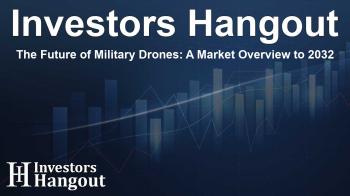The Future of Military Drones: A Market Overview to 2032

Growing Military Drones Market: Key Insights
Emerging technologies and innovations are reshaping the military drones market, expected to surge to USD 34.4 billion by 2032. This growth, averaging an impressive compound annual growth rate (CAGR) of 11.4%, indicates a fundamental shift in defense strategies toward enhanced efficiency and reduced risks for military personnel.
Transformative Role of Unmanned Aerial Systems
Unmanned aerial systems (UAS) are revolutionizing how military operations are conducted. Their capabilities for surveillance, reconnaissance, and autonomous logistics are making them indispensable assets on modern battlefields.
Artificial Intelligence Enhancing Operational Efficiency
AI technologies integrated into military drones allow for real-time intelligence, autonomous threat detection, and strategic battlefield awareness. This ensures military leaders have immediate insights, enhancing decision-making processes and operational tactics.
Revolutionizing Logistics with Autonomous Drones
One of the most significant developments in military logistics is the use of autonomous drones for cargo delivery. These drones significantly reduce the risk to personnel while ensuring the efficient delivery of essential supplies, especially in challenging or hazardous environments.
Technological Advancements in Avionics
Next-generation avionics play a crucial role in expanding the operational capacity of military drones. These systems not only navigate independently but adapt flight paths to meet real-time mission demands, integrating various sensors to enhance intelligence gathering.
The Dominance of Fixed-Wing Drones
Fixed-wing drones hold a significant portion of the market, with over 85% market share in recent estimates. Their effectiveness in long-range surveillance and reconnaissance missions makes them a preferred choice in various military applications, thus significantly shaping market trends.
Potential for Rotor-Wing Drones
On the other hand, rotor-wing drones are gaining recognition for their adaptability in complex environments. Their ability to engage in close-proximity reconnaissance and surveillance signifies growing versatility and market potential.
Applications Driving Market Demand
The primary applications of military drones focus on intelligence, surveillance, reconnaissance, and targeted operations. Accounting for more than 75% of the market, the demand in this sector stems from the increasing need for timely data collection and analysis in military strategies.
Logistics and Transportation Growth
Rapid advancements in drone technology are transforming military logistics. As platforms become more efficient, the capability to deliver supplies and equipment remotely proves essential, minimizing risks and maximizing speed in supply chain management.
Regional Trends in Military Drone Adoption
Navigating global dynamics, North America leads the charge with over 40% market share due to substantial governmental funding and the presence of key manufacturers. This concentration fosters innovation and the enhancement of drone capabilities across military sectors.
Asia-Pacific's Expanding Market
Conversely, the Asia-Pacific region is projected to witness the highest growth rates, fueled by increased government spending on modernization and the adoption of automated systems across the defense sector, resulting in robust investment in drone technologies.
Innovative Future of Military Drones
The expansion of beyond line of sight (BLOS) operations marks a critical development, allowing drones to conduct missions over extensive distances while maintaining stealth. This capability is pivotal for missions requiring precision targeting with minimal risk.
Autonomous Operations: Reducing Risks
With advancements in autonomous technologies, drones are not only becoming more efficient but also safer. By operating independently with minimal human intervention, military drones enhance mission effectiveness while mitigating operational risks.
Key Players Shaping the Market Landscape
The military drone market is fiercely competitive, with distinguished companies innovating and providing cutting-edge technology. Leading entities include AeroVironment, Inc., Northrop Grumman Corporation, and The Boeing Company, among others, all of which contribute to the vibrant landscape of military drones.
Frequently Asked Questions
What is driving the growth of the military drones market?
The military drones market is driven by advancements in AI, enhanced surveillance capabilities, and logistics efficiencies.
How do autonomous drones impact military logistics?
Autonomous drones streamline supply delivery, significantly reducing risks to personnel in combat zones.
What role do fixed-wing drones play in military operations?
Fixed-wing drones are crucial for long-range reconnaissance and intelligence gathering due to their endurance and range.
Which regions show the most growth potential in the military drone market?
Asia-Pacific exhibits the highest growth potential, fueled by increased defense spending and modernization efforts.
Who are the main players in the military drones market?
Leading companies include AeroVironment, Northrop Grumman, and The Boeing Company, driving innovation in the sector.
About The Author
Contact Olivia Taylor privately here. Or send an email with ATTN: Olivia Taylor as the subject to contact@investorshangout.com.
About Investors Hangout
Investors Hangout is a leading online stock forum for financial discussion and learning, offering a wide range of free tools and resources. It draws in traders of all levels, who exchange market knowledge, investigate trading tactics, and keep an eye on industry developments in real time. Featuring financial articles, stock message boards, quotes, charts, company profiles, and live news updates. Through cooperative learning and a wealth of informational resources, it helps users from novices creating their first portfolios to experts honing their techniques. Join Investors Hangout today: https://investorshangout.com/
The content of this article is based on factual, publicly available information and does not represent legal, financial, or investment advice. Investors Hangout does not offer financial advice, and the author is not a licensed financial advisor. Consult a qualified advisor before making any financial or investment decisions based on this article. This article should not be considered advice to purchase, sell, or hold any securities or other investments. If any of the material provided here is inaccurate, please contact us for corrections.

